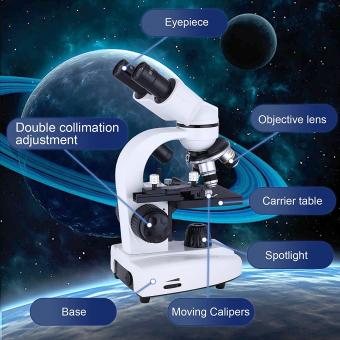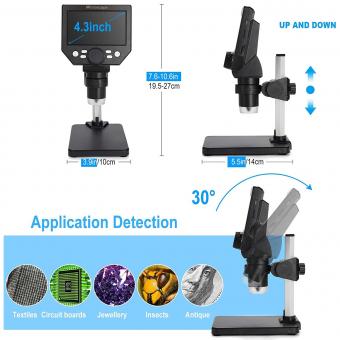Can You See Dna Under A Light Microscope ?
No, DNA cannot be seen under a light microscope. Light microscopes have a limited resolution, typically around 200-300 nanometers, which is not sufficient to visualize individual DNA molecules. DNA is a very small structure, with a diameter of about 2 nanometers, making it far too small to be resolved by a light microscope. To visualize DNA, more advanced techniques such as electron microscopy or fluorescence microscopy are required.
1、 Limitations of Light Microscopy for DNA Visualization
Can you see DNA under a light microscope? The short answer is no. DNA is a molecule that is too small to be directly visualized using a light microscope. Light microscopes use visible light to illuminate and magnify objects, but the resolution of these microscopes is limited by the wavelength of light. The wavelength of visible light is around 400-700 nanometers, which is much larger than the size of a DNA molecule (around 2 nanometers in diameter).
To visualize DNA, scientists typically use techniques such as fluorescence microscopy or electron microscopy. Fluorescence microscopy involves labeling DNA with fluorescent dyes or probes that emit light when excited by a specific wavelength of light. This allows researchers to indirectly visualize DNA by detecting the emitted fluorescence. Electron microscopy, on the other hand, uses a beam of electrons instead of light to create an image. This technique can provide much higher resolution and can be used to directly visualize DNA molecules.
It is worth noting that recent advancements in microscopy techniques have allowed for the visualization of DNA using super-resolution microscopy. Super-resolution microscopy techniques, such as stimulated emission depletion (STED) microscopy and single-molecule localization microscopy (SMLM), can overcome the diffraction limit of light and achieve resolutions on the nanometer scale. These techniques have enabled researchers to observe DNA structures and interactions at a level of detail previously unattainable with conventional light microscopy.
In conclusion, while DNA cannot be directly visualized under a light microscope, there are alternative techniques such as fluorescence microscopy, electron microscopy, and super-resolution microscopy that allow for the visualization of DNA at different levels of resolution.

2、 DNA Staining Techniques for Light Microscopy
DNA is a complex molecule that carries the genetic information of living organisms. Due to its small size, it is not possible to directly visualize DNA under a light microscope. However, with the help of DNA staining techniques, it is possible to indirectly observe DNA using a light microscope.
DNA staining techniques involve the use of specific dyes that bind to DNA molecules, making them visible under a light microscope. One commonly used dye is called DAPI (4',6-diamidino-2-phenylindole), which binds to the minor groove of DNA and emits blue fluorescence when exposed to ultraviolet light. Other dyes, such as ethidium bromide and propidium iodide, can also be used to stain DNA and emit red fluorescence.
These staining techniques allow researchers to visualize DNA in various biological samples, such as cells, tissues, and chromosomes. By staining the DNA, scientists can study the structure, organization, and distribution of DNA within cells. This information is crucial for understanding various biological processes, such as cell division, DNA replication, and gene expression.
It is important to note that while DNA staining techniques provide valuable insights into DNA structure and organization, they do not provide high-resolution images of individual DNA molecules. For more detailed visualization of DNA, techniques such as electron microscopy or fluorescence in situ hybridization (FISH) are required.
In recent years, advancements in microscopy techniques, such as super-resolution microscopy, have allowed for more detailed visualization of DNA. These techniques can overcome the diffraction limit of light microscopy, enabling the visualization of DNA at a higher resolution. However, these methods are still relatively new and require specialized equipment and expertise.
In conclusion, while DNA cannot be directly visualized under a light microscope, DNA staining techniques provide a means to indirectly observe DNA in biological samples. These techniques have been instrumental in advancing our understanding of DNA structure and organization. With the continuous development of microscopy techniques, the visualization of DNA is expected to become even more detailed and informative in the future.

3、 Fluorescence Microscopy for DNA Visualization
Can you see DNA under a light microscope? The short answer is no, DNA cannot be directly visualized using a standard light microscope. DNA molecules are extremely small, with a diameter of about 2 nanometers, which is far below the resolution limit of a light microscope, typically around 200-300 nanometers. Therefore, DNA cannot be observed using traditional bright-field microscopy.
However, there are techniques that allow for the visualization of DNA using light microscopy. One such technique is fluorescence microscopy, which involves labeling DNA with fluorescent dyes or using fluorescently tagged DNA-binding proteins. These dyes or proteins emit light of a specific wavelength when excited by a particular wavelength of light. By using specific dyes or proteins that bind to DNA, researchers can selectively label and visualize DNA within cells or tissues.
Fluorescence microscopy has revolutionized the field of DNA visualization, enabling researchers to study the organization and dynamics of DNA within cells. It has provided valuable insights into various biological processes, such as DNA replication, gene expression, and chromosome structure. Additionally, advancements in fluorescence microscopy techniques, such as confocal microscopy and super-resolution microscopy, have further enhanced the resolution and clarity of DNA imaging.
It is important to note that while fluorescence microscopy allows for the visualization of DNA, it does not provide a direct view of the DNA molecule itself. Instead, it provides information about the location and distribution of DNA within a sample. To study the fine details of DNA structure, such as the double helix, electron microscopy techniques are typically employed.
In conclusion, while DNA cannot be seen directly under a light microscope, fluorescence microscopy techniques have enabled the visualization of DNA within cells and tissues. These techniques have greatly contributed to our understanding of DNA biology and continue to be a powerful tool in molecular and cellular research.

4、 Super-resolution Microscopy for DNA Imaging
Can you see DNA under a light microscope? Traditionally, the answer to this question has been no. DNA is a molecule that is much smaller than the resolution limit of a light microscope, which is around 200-300 nanometers. Therefore, it has been difficult to directly visualize DNA using conventional light microscopy techniques.
However, recent advancements in microscopy technology have allowed for the development of super-resolution microscopy techniques, which have revolutionized the field of DNA imaging. Super-resolution microscopy techniques, such as stimulated emission depletion (STED) microscopy, structured illumination microscopy (SIM), and single-molecule localization microscopy (SMLM), have pushed the resolution limit of light microscopy beyond the diffraction barrier.
These techniques utilize various principles to overcome the diffraction limit and achieve resolutions down to the nanometer scale. By using fluorescent labels or dyes that specifically bind to DNA, researchers can now visualize and study the organization and dynamics of DNA molecules in unprecedented detail.
Super-resolution microscopy has provided valuable insights into the spatial organization of DNA within the nucleus, the dynamics of DNA replication and repair, and the interactions between DNA and various proteins. It has also allowed for the visualization of DNA structures, such as chromatin loops and individual DNA strands.
While super-resolution microscopy has opened up new possibilities for DNA imaging, it is important to note that these techniques require specialized equipment and expertise. Additionally, the labeling and sample preparation methods can introduce artifacts and potential biases. Therefore, careful experimental design and validation are crucial for obtaining accurate and reliable results.
In conclusion, with the advent of super-resolution microscopy techniques, it is now possible to visualize DNA using a light microscope. These techniques have provided unprecedented insights into the structure and dynamics of DNA, advancing our understanding of fundamental biological processes.




































